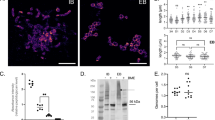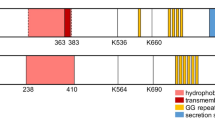Abstract
INTRACELLULAR parasites can be classified into those that reside within a host vacuole and those which grow directly in the host cytoplasm1. Members of the latter group, which includes Rickettsia2, Shigellae3, Trypanosoma cruzi4, and Listeria monocytogenes5,6, possess haemolytic activity associated with the ability to enter the host cytoplasm5–7. Therefore mutants of L. monocytogenes lacking a pore-forming haemolysin, listeriolysin O, do not escape from the endosomal compartment5,6 and consequently fail to become established in the cytoplasm5,8,9. To examine the role of listeriolysin O, we cloned the structural gene for the L. monocytogenes haemolysin, hlyA, into an asporogenic mutant of Bacillus subtilis under the control of an IPTG-inducible promoter10. After being internalized by the macrophage-like cell line J774, haemolytic B. subtilis disrupted the phagosomal membrane and grew rapidly within the macrophage cytoplasm. These results show that a single gene product is sufficient to convert a common soil bacterium into a parasite that can grow in the cytoplasm of a mammalian cell.
This is a preview of subscription content, access via your institution
Access options
Subscribe to this journal
Receive 51 print issues and online access
$199.00 per year
only $3.90 per issue
Buy this article
- Purchase on Springer Link
- Instant access to full article PDF
Prices may be subject to local taxes which are calculated during checkout
Similar content being viewed by others
References
Moulder, J. W. Microbiol. Rev. 49, 298–337 (1985).
Winkler, H. H. & Turco, J. Curr. Top. Microbiol. Immun. 138, 81–107 (1988).
Sansonetti, P. J., Ryter, A., Clerc, P., Maurelli, A. T. & Mounier, J. Infect. Immunity 51, 461–469 (1986).
Nogueira, N. & Cohn, Z. J. exp. Med. 143, 1402–1420 (1976).
Gaillard, J. L., Berche, P., Mounier, J., Richard, S. & Sansonetti . Infect Immunity 55, 2822–2829 (1987).
Tilney, L. G. & Portnoy, D. A. J. Cell Biol. 109, 1597–1608 (1989).
Andrews, N. W. & Whitlow, M. B. Molec. biochem. Parasit. 33, 249–256 (1989).
Portnoy, D. A., Jacks, P. S. & Hinrichs . J. exp. Med. 167, 1459–1471 (1988).
Kuhn, M., Kathariou, S. & Goebel, W. Infect. Immunity 56, 79–82 (1988).
Youngman, P. et al. in Regulation of Prokaryotic Development (eds Smith, I., Slepecky, R. & Setlow, P.) 65–87. (American Society for Microbiology, Washington DC 1989).
Cossart, P. et al. Infect. Immunity 57, 3629–3636 (1989).
Geoffroy, C., Gaillard, J., Alouf, J. E. & Berche, P. Infect. Immunity 55, 1641–1646 (1987).
Havell, E. A. Infect. Immunity 54, 787–792 (1986).
Finlay, B. B. & Falkow, S. Microbiol. Rev. 53, 210–230 (1989).
Smyth, C. J. & Duncan, J. L. in Bacterial Toxins and Cell Membranes (eds Jelaszewicz, J. & Wadstrom, T.) 129–183 (Academic, New York, 1978).
Zuber, P. & Losick, R. J. Bacteriol. 169, 2223–2230 (1987).
Author information
Authors and Affiliations
Rights and permissions
About this article
Cite this article
Bielecki, J., Youngman, P., Connelly, P. et al. Bacillus subtilis expressing a haemolysin gene from Listeria monocytogenes can grow in mammalian cells. Nature 345, 175–176 (1990). https://doi.org/10.1038/345175a0
Received:
Accepted:
Issue Date:
DOI: https://doi.org/10.1038/345175a0
This article is cited by
-
Engineered endosymbionts that alter mammalian cell surface marker, cytokine and chemokine expression
Communications Biology (2022)
-
Listeria exploits IFITM3 to suppress antibacterial activity in phagocytes
Nature Communications (2021)
-
Experimental Listeria–Tetrahymena–Amoeba food chain functioning depends on bacterial virulence traits
BMC Ecology (2019)
-
Mechanisms protecting host cells against bacterial pore-forming toxins
Cellular and Molecular Life Sciences (2019)
-
Antibiotic resistance and tolerance to simulated gastrointestinal conditions of eight hemolytic Bacillus pumilus isolated from pulque, a traditional Mexican beverage
Food Science and Biotechnology (2017)
Comments
By submitting a comment you agree to abide by our Terms and Community Guidelines. If you find something abusive or that does not comply with our terms or guidelines please flag it as inappropriate.



